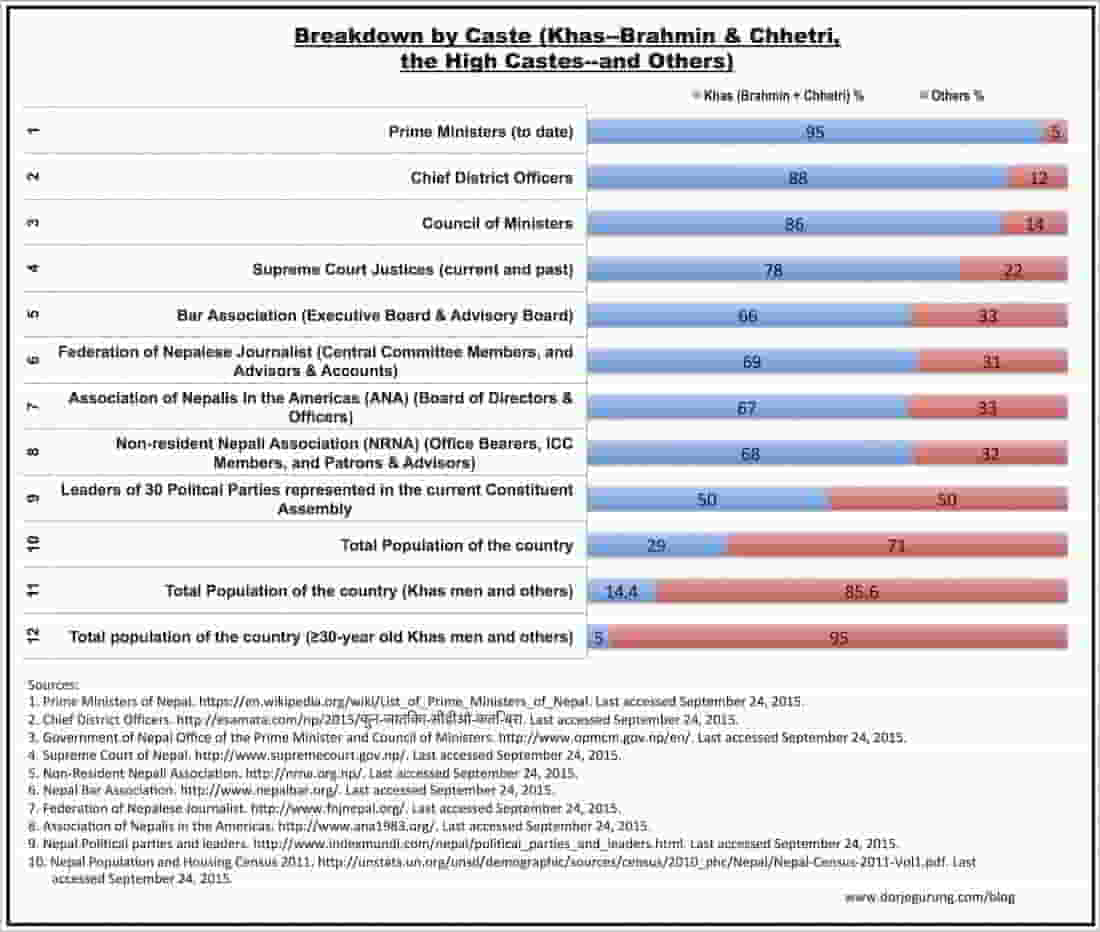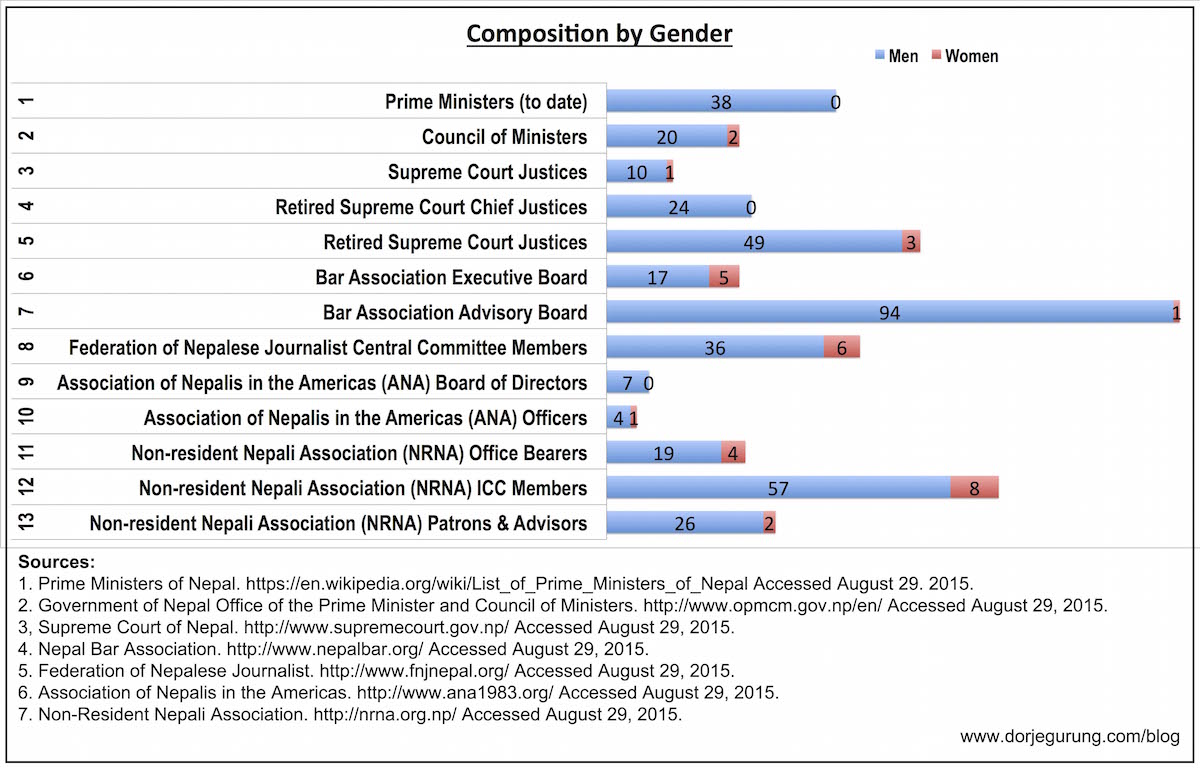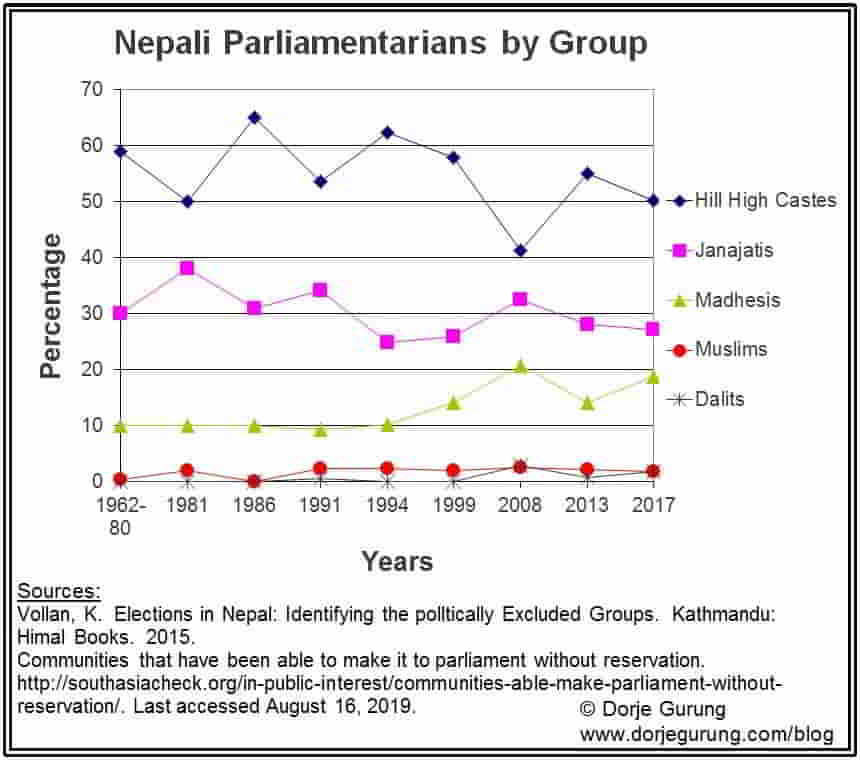My country of Nepal has struggled with completely warped structures throughout its modern history. Along with that, an exploitation of the rest of the population and the resources of the country by the Khas-aryas (men), mostly.
In an undated paper by Dr. Om Gurung (no relation to me), titled Social Inclusion: Policies and Practices in Nepal, the history behind some of those structural issues as well as the root of some of the struggles of the non-Khas-aryas are outlined. He also identifies the indigenous people’s aspirations.
When I first came across it, two years ago, I shared the paper and bits from it in a twitter thread. This is a reproduction of that thread with a few additions here and there. The thread starts off with a link to the paper.
#SocialInclusion: Policies & Practices in #Nepal by Om Gurung. (See rest of the thread for more.) https://t.co/EumPcp3YtS 1/n
— Dorje Gurung (@Dorje_sDooing) February 10, 2017
In the second tweet, I shared something interesting I discovered. Only in the 9th 5-year development plan, in 1997, did the GoN (the Government of Nepal) include — for the FIRST TIME — policies and programs related to the development of the marginalized. Reproduced below is the important bits from the screenshot shared in the tweet.
“In the history of the planned development efforts, the Government of Nepal included, for the first time, policies and programs related to the development of indigenous peoples, women, Mdhesis, Dalits and other marginalized communities in the Ninth Five-Year Plan. In this Plan, the government has admitted its weaknesses to accommodate these communities in the mainstream development programs of the country. […]
“But in practice, these communities did not participate in the development planning and programming of the Ninth Five-Year Plan because the government never consulted them.” (p. 2)
In (1997) the 9th 5-yr development plan, GoN includes, 4 d 1ST TIME, policies & programs related to d development of d #marginalized. 2/n pic.twitter.com/FfFSe1UVdK
— Dorje Gurung (@Dorje_sDooing) February 10, 2017
Dr. Gurung goes on to argue how GoN was not serious and honest about the development of the marginalized. The GoN rather brought about their displacement from their land and territories.
“But the government did not look honest and serious to implement the development programs for these communities. Instead, its development programs displaced indigenous peoples and other marginalized communities from their lands and territories.” (p. 3)
But GoN, not serious & honest abt their development, brought abt displacement of the marginalized from their land & territories. 3/n pic.twitter.com/SpJa8R5wF0
— Dorje Gurung (@Dorje_sDooing) February 10, 2017
What the land reform programs led to was no different from what the Birtha and Jagir systems Prithvi Narayan Shah and his sons implemented. Studies show (see second tweet below, tweet 4/n), land “Ownership by caste is as expected: higher castes own more land & rent in less.”
More abt land reform&ownership: “Ownership by caste is as expected: higher castes own more land & rent in less.” https://t.co/feKMgXfOHI 4/n
— Dorje Gurung (@Dorje_sDooing) February 10, 2017
(As a side note, reading the paper, I didn’t understand if there actually was any land reforms implemented post-1997, after the 9th five-year plan was drafted.)
Not surprisingly, “A comparison of poverty rate, per capita income, literacy etc. between different groups based on a 2003-04 study” show what anyone with some knowledge of the history of the country would have been able to guess. Namely:
“The report of National Living Standards Survey (NLSS) 2003/ 2004 shows that indigenous peoples and other marginalized communities have access to social services and other economic opportunities far behind the national average.” (p. 3)
A comparison of poverty rate, per capita income, literacy etc. between different groups based on a 2003-04 study. 5/n pic.twitter.com/gFp9SHbp7N
— Dorje Gurung (@Dorje_sDooing) February 10, 2017
Dr. Gurung further argues that the Millenium Development Goals “have insignificant impact on [the] lives of the marginalized in #Nepal.”
“But several case studies reveal that MDGs have no significant impact on the life of poor peoples (cf. Bhattachan and Chemjong 2006, Bhattachan and Webster 2005). With the exception of the basic primary education, MDG-related programs have not reached the marginalized communities. The government and donor agencies have no meaningful policies and programs on consultation and participation of indigenous peoples, women, Madhesis, Dalits and other marginalized communities in the planning processes and implementation stages of poverty reduction strategy programs.” (p. 4)
#MDG‘s have insignificant impact on lives of the marginalized in #Nepal. 6/n pic.twitter.com/5upEZraz8R
— Dorje Gurung (@Dorje_sDooing) February 10, 2017
Here’s a bit of history lesson on the root of the legacy we, the non-hill so-called high caste Hindu Nepali citizens have been living under. “The Hindu rulers transformed land tenure systems, codified Hindu caste-based laws & imposed Nepali language to consolidate hold on power.”
“The indigenous patterns of communal life and economy that existed in the hill and mountain regions of Nepal were subjected to penetration by dominant Hindu caste people. Hindu rulers created conditions for perpetuating their penetration by the transformation of land tenure systems, codification of Hindu laws and imposition of Nepali language. The structure of Nepali society into a hierarchical segmentation along the line of Hindu caste system with the ritual claim of superior and inferior as well as pure and impure excluded indigenous peoples, women and Dalits from the national social, cultural, economic and political life.” (p. 5)
Hindu rulers transformed land tenure systems, codified Hindu caste-based laws & imposed Nepali language to consolidate hold on power. 7/n pic.twitter.com/1Lim8peVMU
— Dorje Gurung (@Dorje_sDooing) February 10, 2017
The consequences of that on indigenous populations were many. For my own community of ethnic-Tibetans from Mustang district, one was to make us “disown” our own culture and heritage by adopting other hill tribe surnames. such as Gurung or Lama, to avoid being discriminated and to fit better into the (Hindu) Nepali society the rulers created and expected everyone else to embrace without question it. Another was to give ourselves Nepali (Hindu) names, and still another was to celebrate Hindu festivals!
The next tweet is also about a bit of history, history of “How the feudal system of the country, long ago, enabled the transfer of land holdings from the indigenous population to the privileged.”
“The Gorkha rulers confiscated the kipat (communal) lands from indigenous peoples and converted them into raikar (state-owned) so that the state could levy taxes on them to support ruling classes and military expenditure. The state also granted confiscated lands to non-local settlers under various forms of birta, jagir and rakam tenure. Birta land grants were made to loyal followers of the new monarchy as symbol of patronage or as ritual gifts. Birta receivers were usually from so-called higher caste and members of royal family. They did not have to pay the tax. Jagir land grants were made to civil and military personnel for their services and loyalty to the state in lieu of their emoluments.” (p. 5)
How the feudal system of the country, long ago, enabled d transfer of land holdings from the indigenous population to the privileged. 8/n pic.twitter.com/pR65RqPxoL
— Dorje Gurung (@Dorje_sDooing) February 10, 2017
The dire consequences of “The feudal system’s land reform and other programs [was to impoverish] the indigenous population, particularly the #Madhesis in the Terai especially [the] Tharus.”
“The government’s land reform and park policies and uncontrolled hill-Terai migration have resulted in a progressive impoverishment of the indigenous and Madhesi peoples, particularly in the Tarai (plain). Until 1950s/60s, Tharus, for example, were land owners of west Tarai of Nepal. Now the process of migration and population pressure as a result of government’s land reform policy has converted the Tharus into land tillers and eventually to agricultural laborers in the form of Kamaiyas, bonded laborers.” (p. 6)
The feudal system’s land reform & other programs impoverished d indigenous population, particularly d #Madhesis in d Terai, esp. Tharus. 9/n pic.twitter.com/CGtWW2bDkz
— Dorje Gurung (@Dorje_sDooing) February 10, 2017
The autocratic regime of the Shah dynasty was toppled in 1990. “In the 1990s, small improvement in representation following democracy (in 1990), though [and sadly] indigenous leaders are beholden to political parties [instead of their communities].”
“Indigenous peoples who constitute 37.2 percent of the total population (23million) of the country represented only 25.2 percent in 1991, 18.5 percent in 1994 and 18.4 percent seats in 1999 in the legislature. Similarly, Madhesis had 8.7 percent in 1991, 10.7 percent in 1994 and 14.1 percent in 1999. Dalits had only one elected Member in 1991 and no representation in 1994 and 1999. Similarly, women, who comprise 51 percent of the total population in the country, had no more than 5 percent representation in the parliament from 1991 to 1999. […]
“In reality, the elected members from indigenous people do not represent the interests of their own communities as they are elected from their affiliated political parties. In the executive bodies and bureaucracy, indigenous peoples and other marginalized communities have lower representation (indigenous peoples 12%, Madhesis 5%, Dalits 1.3% and religious minoirites 1.1%)).” (p. 9)
In 1990’s, small improvement in representation following democracy (in 1990), though indigenous leaders r beholden 2 political parties. 10/n pic.twitter.com/My48TKhWLK
— Dorje Gurung (@Dorje_sDooing) February 10, 2017
One of the consequences of the the non-hill so-called high caste Hindu representatives being beholden to political parties more than their communities was, for example, the passing of the 2015 constitution!
Following the end of the civil war and the second People’s Revolution (Jana Andolan II), the “Nominations for the first election to Constituent assembly were MUCH better than d level of representation in the parliament of the 1990” noted Dr. Gurung.
“For the proportional representation, Nepali congress has nominated 30 percent candidates from indigenous peoples, 13 percent candidates from Madhesis, 14 percent from Dalits, and 2 percent from Muslims, whereas CPN-UML has nominated 34 percent indigenous peoples, 9 percent Madhesis, 16 percent Dalits and 4 percent Muslims for the proportional representation. In the same way, CPN (Maoist) has nominated 36 percent indigenous peoples, 11 percent Madhesis, 15 percent Dalits and 2 percent Muslims for the proportional representation in the CA.” (p. 11)
Nominations 4 d first election to Constituent Assembly were MUCH better than d level of representation in d parliaments of the 1990’s. 11/n pic.twitter.com/uc0XNDSGHO
— Dorje Gurung (@Dorje_sDooing) February 10, 2017
What’s been the representation to the parliament like over the last 60 years though? Here’s a chart which shows just that. Decide for yourself! (Click on the chart for the original.)
What about the representation in other bodies, evidence of the warped structures? See image below! (Click on the chart for the original.)

As for the women, they “lose some and win some in the first Constituent Assembly elections.”
“Half of the total proportional candidates for CA come from women. Despite the government’s political commitment and constitutional provision of 33 percent of women’s representation in the state mechanism, these big three political parties have failed to nominate 33 percent of women as FPTP candidates. Thus, compared to indigenous peoples and Madhesis, only 30 (12%) women have been elected in the CA through the FPTP electoral system. But women occupy almost half of the total proportional seats in the CA. The election result shows that of the total declared 601 seats in the CA, women occupy 197 (32.77%) seats in the Constituent Assembly. Similarly, indigenous peoples occupy 219 (36.43%) seats, Madhesis occupy 117 (19.46%) seats, Dalits occupy 49 (9%) and Muslims occupy 17 (2.82%) in the constituent assembly.” (p. 11)
#Women lose some & win some in the first Constituent Assembly elections. 12/n pic.twitter.com/WGmrNhaPHz
— Dorje Gurung (@Dorje_sDooing) February 13, 2017
Here’s a chart showing how they are NOT represented well at all. (Click on the chart for the original.)

Following the elections to the first Constituent Assembly and the passage of the interim constitution, the “3-yr Interim Development Plan recognizes centralized and unitary structure of state as responsible for the plight of marginalized groups.”
“The Three-year Interim Development Plan also admits that the centralized and unitary structure of the state is responsible for the social and economic backwardness of indigenous peoples, women, Madhesis, Dalits and other marginalized communities.” (p. 12)
3-yr Interim Development Plan recognizes centralized & unitary structure of state as responsible for d plight of marginalized groups. 13/n pic.twitter.com/IzHSbxibm8
— Dorje Gurung (@Dorje_sDooing) February 13, 2017
Rounding off the paper, Dr. Gurung identifies what the marginalized groups want.
“They demand human rights-based development programs such as food security, education, health, decent works and income generating activities at the community level.” (p. 14)
What do the marginalized groups demand? n/n pic.twitter.com/3JXJ4DDmuj
— Dorje Gurung (@Dorje_sDooing) February 13, 2017
There you go!
What do you think?
References
Added after the publication of the blog post for their relevance.
Himal Southasia (Nov. 19, 2018). Bahunvada: Myth or reality? [Added Jan. 7, 2021.]


